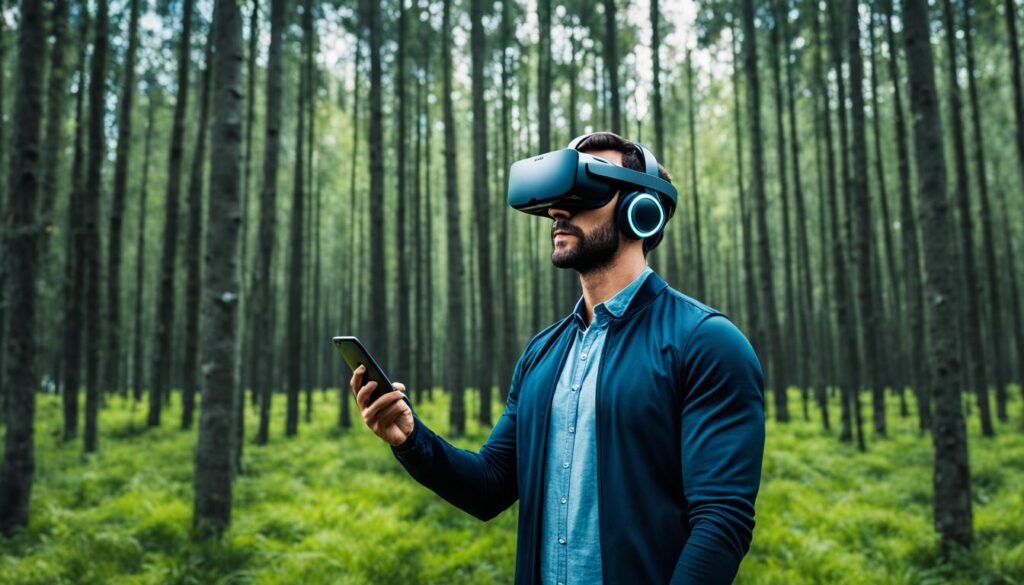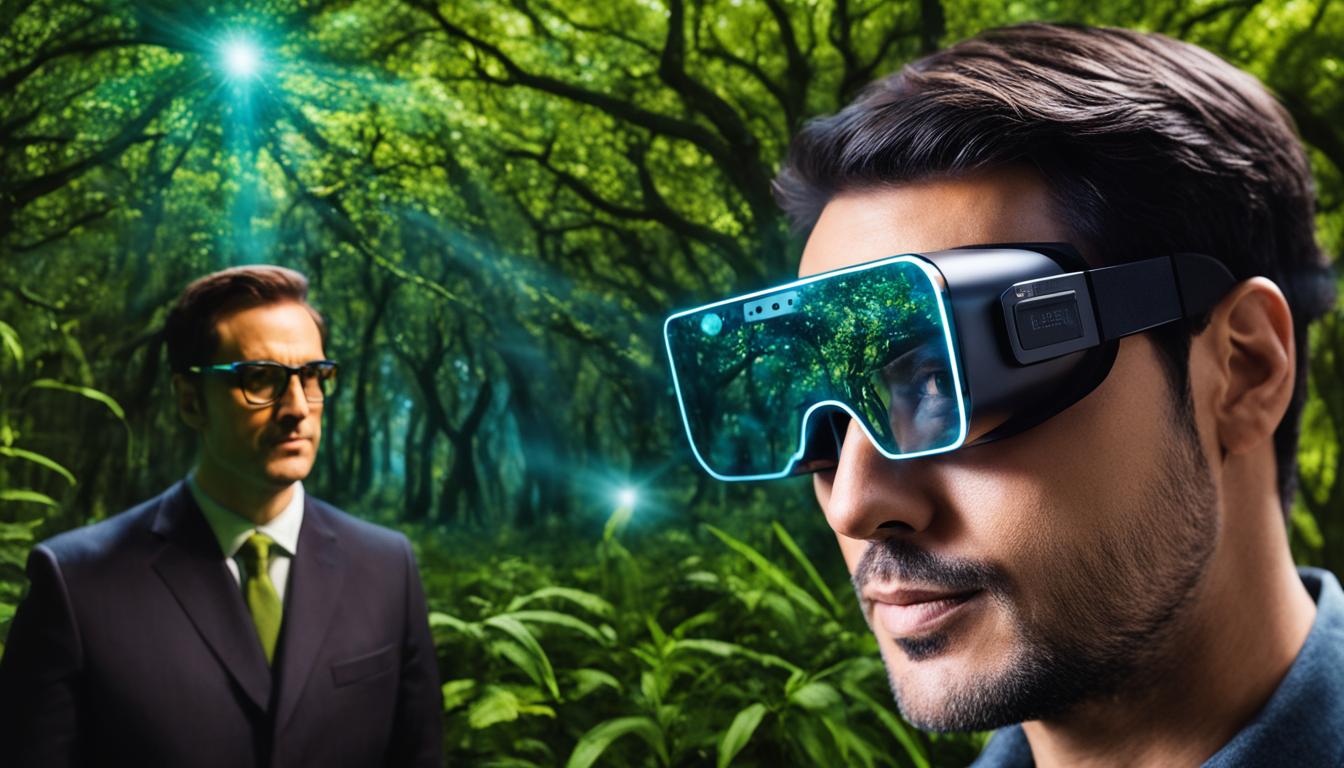Augmented reality (AR) technology has revolutionized the way we perceive and interact with the world around us. By seamlessly integrating virtual information with real scenes, AR enhances our perception and creates immersive experiences. But have you ever wondered how AR allows light from the outside world to enter and influence the virtual environment?
Understanding the role of light in augmented reality is crucial for achieving realistic integration of virtual objects into real scenes. While geometric and temporal consistency have been largely solved, accurately estimating the lighting parameters of real environments remains a challenge. In outdoor AR applications, this becomes even more critical as it directly affects lighting consistency and user immersion.
There are various methods to estimate lighting conditions in AR, such as marker-based methods, auxiliary equipment-based methods, and image analysis methods. However, these methods may not always be practical or accurate in outdoor environments. To address this, new techniques are being developed that utilize multi-source geographic information to achieve lighting consistency in real-time outdoor AR systems without the need for additional devices or visual information.
By allowing external light into the AR experience, we create a more immersive and realistic environment. Let’s explore how AR technology enables external light to enhance our visual experiences.
Contents
- 1 Enhancing Visual Perception in Augmented Reality with Natural Light
- 2 Overcoming Technical Constraints with LED Lighting in Augmented Reality
- 3 Conclusion
- 4 FAQ
- 4.1 How does augmented reality allow light from outside?
- 4.2 What are the benefits of integrating natural light in augmented reality?
- 4.3 How does LED lighting enhance visual perception in augmented reality?
- 4.4 What is the role of LED lighting in overcoming technical constraints in augmented reality?
- 4.5 How do color estimation techniques improve realistic lighting in outdoor augmented reality?
- 4.6 What is the future potential of LED-enhanced augmented reality?
- 5 Source Links
Key Takeaways:
- AR technology integrates virtual information with real scenes to enhance perception.
- Accurately estimating lighting conditions in outdoor AR is crucial for lighting consistency and user immersion.
- Existing methods for lighting estimation in AR may not be practical or accurate in low-information outdoor environments.
- New techniques utilizing multi-source geographic information are being developed for lighting consistency in outdoor AR systems.
- Allowing external light in AR creates a more immersive and realistic experience.
Enhancing Visual Perception in Augmented Reality with Natural Light
LED lighting plays a crucial role in enhancing the visual perception of augmented reality experiences. LED lights offer a wide color spectrum, allowing for realistic and vibrant experiences in AR. By incorporating natural light into AR, virtual objects can be rendered with better clarity, color accuracy, and brightness, creating a seamless blend between the physical and digital worlds.
The use of LED lighting also allows for customizable lighting conditions, enhancing user engagement and creating immersive environments. Furthermore, LED lighting helps overcome technical constraints in AR applications by compensating for low-light conditions and providing bright and uniform lighting. This improves the integration of virtual objects into the real world and ensures a more comfortable user experience, particularly on mobile devices.
Overall, the integration of natural light through LED lighting enhances the visual experience and realism in augmented reality.
LED lighting plays a key role in enhancing the visual perception of augmented reality experiences. By integrating natural light, AR can achieve better clarity, color accuracy, and brightness in rendering virtual objects, resulting in a seamless blend between the physical and digital worlds. Customizable lighting conditions provided by LED lights enhance user engagement and create immersive environments. Additionally, LED lighting helps overcome technical constraints in AR applications, compensating for low-light conditions and ensuring consistent and bright lighting for a comfortable user experience, especially on mobile devices. The integration of natural light through LED lighting optimizes the AR visual experience, bringing forth enhanced realism and immersion.
Overcoming Technical Constraints with LED Lighting in Augmented Reality
Augmented reality (AR) applications often encounter technical constraints that can significantly impact the user experience. In order to address these limitations, the role of LED lighting in AR becomes paramount. LED lighting offers numerous advantages for optimizing lighting in AR applications, ensuring seamless integration of virtual objects into the user’s environment, regardless of the lighting conditions.
LED lighting plays a crucial role in compensating for low-light conditions, providing bright and uniform lighting that enhances the overall visual quality of AR experiences. By utilizing LED technology, AR applications can achieve better immersion and realism, creating a more engaging user experience.
One of the key benefits of LED lighting is its energy efficiency, long lifespan, and low power consumption. These characteristics make LED lighting an ideal choice for portable AR devices, enabling users to enjoy AR experiences without worrying about frequent battery drain.
To optimize lighting in AR applications, LED technology offers the capability to adjust the lighting conditions according to the specific requirements of different AR scenarios. This level of control ensures that virtual objects are accurately illuminated, resulting in an enhanced integration with the real world.
By using LED lighting in AR applications, the overall performance and user satisfaction can be significantly improved. The seamless integration of virtual objects into the real world, combined with optimized lighting conditions, creates a more immersive and realistic experience for AR users.
Advantages of LED Lighting in Augmented Reality
| Advantages | Description |
|---|---|
| Compensates for low-light conditions | LED lighting ensures consistent and bright illumination, overcoming the limitations of insufficient ambient lighting. |
| Enhances visual quality | The wide color spectrum of LED lighting enables realistic rendering of virtual objects with improved clarity, color accuracy, and brightness. |
| Energy-efficient and long lifespan | LED lighting offers energy efficiency, long lifespan, and low power consumption, making it an ideal choice for portable AR devices. |
| Optimizes lighting conditions | LED technology allows for precise adjustment of lighting conditions, optimizing the integration of virtual objects with the real world. |
| Improves performance and user satisfaction | By enhancing the overall visual experience and creating a more immersive environment, LED lighting contributes to improved performance and user satisfaction in AR applications. |
By leveraging the benefits of LED lighting, AR applications can overcome technical constraints and deliver enhanced visual experiences. The role of LED lighting in AR is integral to optimizing lighting conditions, improving integration, and creating a more immersive and realistic augmented reality.

Improved Realism and Immersion
By accurately estimating the lighting parameters, color estimation techniques ensure that virtual objects blend seamlessly with the real world, resulting in improved realism and immersion. The virtual objects appear more natural, as the colors match the lighting conditions of the real environment.
A More Engaging AR Experience
Color consistency enhances the overall visual experience in augmented reality, making it more engaging for users. When the virtual objects reflect the correct color tones and lighting conditions of the real environment, the AR experience becomes more immersive and captivating.
Overcoming Color Differentials
The color differentials between real and virtual objects can be jarring in augmented reality. Color estimation techniques help bridge this gap by minimizing the differences and ensuring a harmonious blend between the physical and virtual elements.
Improving Color Consistency
Consistency is key to creating a believable augmented reality experience. By accurately estimating lighting parameters and applying them to virtual objects, color estimation techniques improve color consistency, resulting in a more cohesive and realistic AR environment.
To sum up, color estimation techniques play a vital role in achieving realistic lighting and improving the overall visual quality of outdoor augmented reality. By overcoming color differentials and enhancing color consistency, these techniques enhance the immersion and realism of AR experiences.
Conclusion
LED lighting and augmented reality (AR) have formed a powerful alliance that is transforming visual experiences. By enhancing visual perception and creating immersive environments, LED lighting significantly enhances the immersion and realism of augmented reality. This combination of technologies has immense potential in numerous industries, including entertainment, education, and retail.
As technology continues to advance, LED lighting is poised to further revolutionize augmented reality experiences. With advanced lighting capabilities, real-time color correction, and seamless interaction with the physical world, LED lighting will continue to push the boundaries of what is possible in AR.
The impact of LED lighting in augmented reality cannot be overstated. It has overcome technical constraints by compensating for low-light conditions and providing bright and uniform lighting, ensuring that virtual objects seamlessly integrate into the real world. Additionally, LED lighting offers energy efficiency, a long lifespan, and low power consumption, making it ideal for portable AR devices.
The future of augmented reality with LED lighting holds limitless possibilities. As LED technology continues to evolve, we can expect even more realistic and immersive visual experiences. Augmented reality with LED lighting is set to transform the way we perceive and interact with our surroundings, illuminating a future filled with groundbreaking possibilities.
FAQ
How does augmented reality allow light from outside?
Augmented reality technology allows light from outside by integrating virtual information with real scenes. This integration creates a seamless blend between the physical and digital worlds, enhancing users’ perception of the real world.
What are the benefits of integrating natural light in augmented reality?
Integrating natural light in augmented reality enhances the visual experience by improving clarity, color accuracy, and brightness of virtual objects. It creates a more immersive and realistic environment for users, fostering deeper engagement and immersion.
How does LED lighting enhance visual perception in augmented reality?
LED lighting offers a wide color spectrum, allowing for realistic and vibrant experiences in augmented reality. By incorporating natural light, LED lighting enhances the integration of virtual objects into the real world, improving visual quality and creating a more immersive experience.
What is the role of LED lighting in overcoming technical constraints in augmented reality?
LED lighting compensates for low-light conditions and provides bright and uniform lighting in augmented reality applications. This ensures seamless integration of virtual objects into various lighting environments and improves the overall user experience, especially on mobile devices.
How do color estimation techniques improve realistic lighting in outdoor augmented reality?
Color estimation techniques analyze the color generated by the outdoor light source and apply the defined values to the virtual light source. This reduces the color differential between real and virtual objects, enhancing the immersion and realism of outdoor augmented reality systems.
What is the future potential of LED-enhanced augmented reality?
LED-enhanced augmented reality holds limitless potential in various industries, revolutionizing visual experiences in entertainment, education, and retail. With advancements in LED lighting technology, the future of augmented reality looks promising, offering advanced lighting capabilities and seamless interaction with the physical world.




